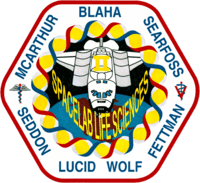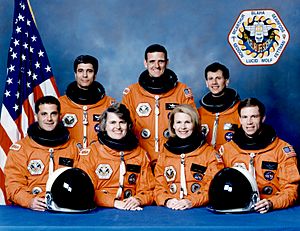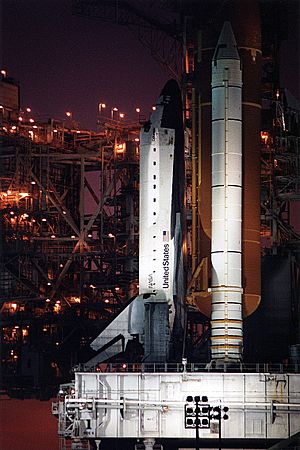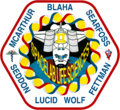STS-58 facts for kids

Spacelab module LM2 in Columbia's payload bay, serving as the Spacelab Life Sciences-2 laboratory
|
|
| Names | Space Transportation System-58 SLS-2 Spacelab Life Sciences-2 |
|---|---|
| Mission type | Biosciences |
| Operator | NASA |
| Mission duration | 14 days, 0 hour, 12 minutes, 32 seconds (achieved) |
| Distance travelled | 9,400,000 km (5,800,000 mi) |
| Orbits completed | 225 |
| Spacecraft properties | |
| Spacecraft | Space Shuttle Columbia |
| Landing mass | 103,146 kg (227,398 lb) |
| Payload mass | 11,803 kg (26,021 lb) |
| Crew | |
| Crew size | 7 |
| Members |
|
| Start of mission | |
| Launch date | 18 October 1993, 14:53:10 UTC |
| Rocket | Space Shuttle Columbia |
| Launch site | Kennedy Space Center, LC-39B |
| Contractor | Rockwell International |
| End of mission | |
| Landing date | 1 November 1993, 15:05:42 UTC |
| Landing site | Edwards Air Force Base, Runway 22 |
| Orbital parameters | |
| Reference system | Geocentric orbit |
| Regime | Low Earth orbit |
| Perigee | 284 km (176 mi) |
| Apogee | 294 km (183 mi) |
| Inclination | 39.00° |
| Period | 90.30 minutes |
 STS-58 mission patch  Standing: John E. Blaha, William S. McArthur, Martin J. Fettman Seated: David A. Wolf, Shannon W. Lucid, Margaret Rhea Seddon, Richard A. Searfoss |
|
STS-58 was an exciting space mission by NASA. The Space Shuttle Columbia blasted off from Kennedy Space Center, Florida, on October 18, 1993. Its main goal was to study how the human body changes when living in space. This mission also marked the first time a special computer program called PILOT was used to help astronauts practice landing. It was the last time Columbia landed at Edwards Air Force Base, California.
Contents
- Meet the STS-58 Astronaut Crew
- Mission Highlights: Science in Space
- How Does Space Affect the Body?
- Studying Bones and Balance
- Small Challenges in Space
- Helping Bodies Adjust to Space
- Blood, Bones, and Calcium
- Talking to Students from Space
- Practicing Landing in Space
- Rodent Studies and Orbit Adjustments
- Measuring Forces in Orbit
- A Friendly Space Record
- Observing Earth from Above
- Images for kids
Meet the STS-58 Astronaut Crew
The STS-58 mission had a crew of seven brave astronauts. They worked together to complete all the important science experiments in space.
Who Was the Commander?
- John E. Blaha was the Commander. This was his fourth trip to space!
Who Was the Pilot?
- Richard A. Searfoss was the Pilot. This was his first time flying in space.
Who Were the Mission Specialists?
- Margaret Rhea Seddon was Mission Specialist 1. This was her third and final space flight.
- William S. McArthur was Mission Specialist 2. This was his first space mission.
- David A. Wolf was Mission Specialist 3. This was also his first time in space.
- Shannon W. Lucid was Mission Specialist 4. This was her fourth journey to space.
Who Was the Payload Specialist?
- Martin J. Fettman was Payload Specialist 1. This was his only space flight.
Backup Crew Members
Sometimes, other astronauts train to be ready in case someone on the main crew cannot fly.
- Jay C. Buckey was a backup Payload Specialist.
- Laurence R. Young was also a backup Payload Specialist.
Mission Highlights: Science in Space
STS-58 was all about life sciences research in 1993. The crew of Columbia did many experiments to learn how human bodies adapt to being weightless in space.
How Does Space Affect the Body?
The experiments looked at different body systems. These included the heart and blood, how the body controls itself, DNA, the balance system, and bones and muscles. The astronauts also studied 48 rats in special cages.
The information from STS-58, combined with data from an earlier mission (STS-40 in 1991), gave scientists a lot of detailed facts. This was the most detailed study of how bodies work in space since the Skylab program in the 1970s.
Studying Bones and Balance
Astronauts worked on understanding why bone tissue can be lost in space. They also studied how microgravity affects what people feel and sense. Two experiments on the second day looked at space motion sickness and changes in how astronauts perceive things.
Astronauts Lucid and Fettman wore a special headset called an Accelerometer Recording Unit (ARU). This device recorded their head movements throughout the day.
Small Challenges in Space
On October 19, 1993, a small problem came up. A circuit breaker tripped, which briefly cut power to one of the rodent cages. Flight controllers on Earth quickly figured out it wasn't a short circuit. They reset the breaker, and power was back on for the cage.
Helping Bodies Adjust to Space
On the third day of the flight, astronauts McArthur and Blaha started using a device called the Lower Body Negative Pressure device. This device helps test ways to prevent the bad effects of microgravity on the body. All three flight crew members collected samples of their urine and saliva. They also kept track of their exercise, food, and fluid intake. This was part of a study to understand the energy and nutrition needs of astronauts on long space flights.
On October 20, 1993, the space toilet had a small leak around its filter door. The crew cleaned up a tiny amount of water. As a safety step, they used a backup fan unit to separate fluid from the air before cycling the air back into the cabin.
Blood, Bones, and Calcium
On October 21, 1993, Mission specialists Margaret Rhea Seddon (who was the lead scientist for the payload), Shannon Lucid, David Wolf, and Payload specialist Martin Fettman collected more blood and urine samples. These samples were for a series of metabolic experiments. Some samples were for a follow-up study on calcium absorption.
This experiment, led by Dr. C. D. Arnaud, studied how calcium is used in bone metabolism in space. Early results from a previous mission suggested that bones might lose density in space. This happens because bones break down more, and the body doesn't make enough new bone to replace it.
Talking to Students from Space
On October 22, 1993, astronauts Blaha and Searfoss used the on-board ham radio (called SAREX-2) to talk to school children. They spoke with students at Sycamore Middle School in Pleasant View, Tennessee, Gardendale Elementary in Pasadena, Texas, and Naparima College in Trinidad and Tobago.
Astronaut Searfoss also tested a device called the Standard Interface Rack (SIR). This test showed that one astronaut could easily move equipment from one place to another in the shuttle. This helps make sure that all the connections for power and data still work well.
Practicing Landing in Space
Another important test on Columbia was the "Portable In-flight Landing Operations Trainer" (PILOT). This was a laptop computer simulator. It helped the commander and pilot practice landing the shuttle. This was important for keeping their skills sharp during longer space flights. The laptop used a joystick, just like the one used to fly the shuttle during landing. This simulator was used on many missions, even up to the very last Space Shuttle flight (STS-135).
Rodent Studies and Orbit Adjustments
On October 23, 1993, the science crew focused on studying the 48 rodents in the Spacelab science workshop. They took blood from the tails of some rodents and injected a special substance to measure their plasma volume. They took more blood later to see how weightlessness affected the animals' red blood cell count.
After making several ham radio calls and using a special vacuum bag to help their bodies get used to Earth's environment again, the crew adjusted Columbia's orbit. Commander John Blaha, Pilot Richard Searfoss, and Mission Specialist William McArthur fired one of the orbital maneuvering system engines. This lowered the shuttle's orbit slightly. This change would give them more chances to land if the mission needed to be extended due to weather or a system problem.
Measuring Forces in Orbit
On October 27, 1993, Pilot Rick Searfoss performed some maneuvers with Columbia. This was part of the Orbital Acceleration Research Experiment (OARE). The main goal was to accurately measure the forces that act on the shuttle while it's in orbit and when it first starts to re-enter Earth's atmosphere. This information helps scientists plan future microgravity research flights. These experiments need a very quiet, stable environment to get the best data.
On October 28, 1993, after a half-day off, the astronauts continued their scientific work. They kept collecting data on how humans and animals adapt to living without Earth's gravity.
A Friendly Space Record
Payload commander Rhea Seddon sent a special message to her husband, Robert L. Gibson, who was also an astronaut. She had just spent more time in space than he had! "He's still a really good guy, I still love him a lot, but I've got more hours in space than he does, so there!" she joked. However, she admitted that he had more launches and landings, having flown four times compared to her three.
Observing Earth from Above
Pilot Rick Searfoss also took time to take infrared photography of wildfires burning in southern California. He shared that the crew was thinking of the firefighters and residents affected by the fires. He hoped the fires would be controlled soon. The photographs he took were among about 4,000 images that would be sent back to Earth. Meteorologists, geologists, ecologists, and archeologists would study these photos after the flight.
Images for kids




